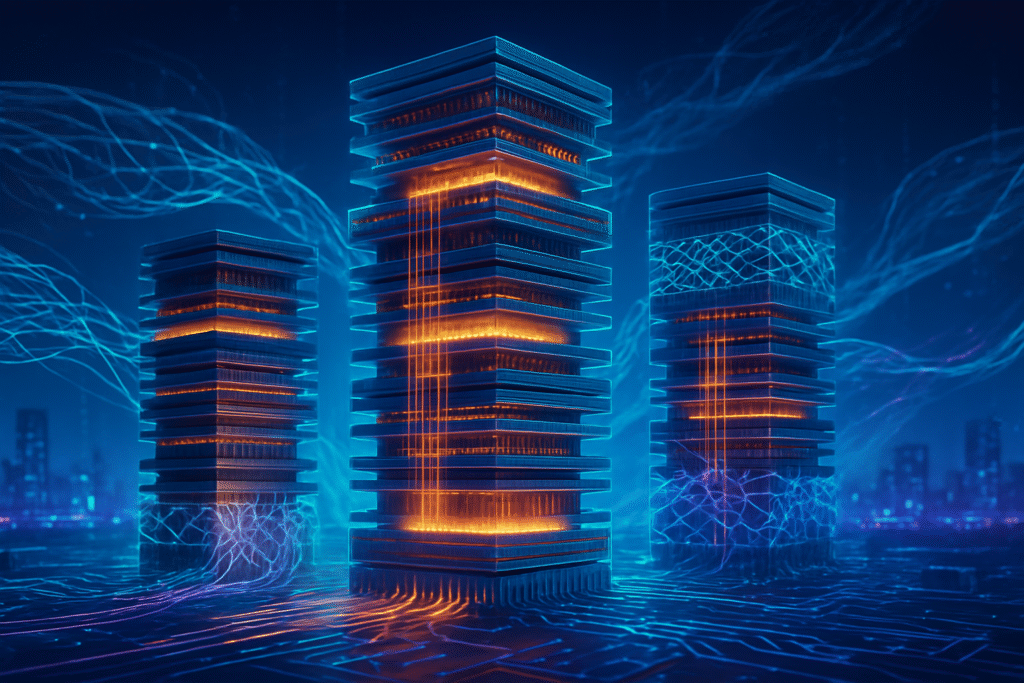
The relentless advance of Artificial Intelligence (AI) is unleashing an unprecedented surge in demand for specialized memory chips, fundamentally reshaping the semiconductor industry and ushering in what many are calling an "AI supercycle." This escalating demand has immediate and profound significance, driving significant price hikes, creating looming supply shortages, and forcing a strategic pivot in manufacturing priorities across the globe. As AI models grow ever more complex, their insatiable appetite for data processing and storage positions memory as not merely a component, but a critical bottleneck and the very enabler of future AI breakthroughs.
This AI-driven transformation has propelled the global AI memory chip design market to an estimated USD 110 billion in 2024, with projections soaring to an astounding USD 1,248.8 billion by 2034, reflecting a compound annual growth rate (CAGR) of 27.50%. The immediate impact is evident in recent market shifts, with memory chip suppliers reporting over 100% year-over-year revenue growth in Q1 2024, largely fueled by robust demand for AI servers. This boom contrasts sharply with previous market cycles, demonstrating that AI infrastructure, particularly data centers, has become the "beating heart" of semiconductor demand, driving explosive growth in advanced memory solutions. The most profoundly affected memory chips are High-Bandwidth Memory (HBM), Dynamic Random-Access Memory (DRAM), and NAND Flash.
Technical Deep Dive: The Memory Architectures Powering AI
The burgeoning field of Artificial Intelligence (AI) is placing unprecedented demands on memory technologies, driving rapid innovation and adoption of specialized chips. High Bandwidth Memory (HBM), DDR5 Synchronous Dynamic Random-Access Memory (SDRAM), and Quad-Level Cell (QLC) NAND Flash are at the forefront of this transformation, each addressing distinct memory requirements within the AI compute stack.
High Bandwidth Memory (HBM)
HBM is a 3D-stacked SDRAM technology designed to overcome the "memory wall" – the growing disparity between processor speed and memory bandwidth. It achieves this by stacking multiple DRAM dies vertically and connecting them to a base logic die via Through-Silicon Vias (TSVs) and microbumps. This stack is then typically placed on an interposer alongside the main processor (like a GPU or AI accelerator), enabling an ultra-wide, short data path that significantly boosts bandwidth and power efficiency compared to traditional planar memory.
HBM3, officially announced in January 2022, offers a standard 6.4 Gbps data rate per pin, translating to an impressive 819 GB/s of bandwidth per stack, a substantial increase over HBM2E. It doubles the number of independent memory channels to 16 and supports up to 64 GB per stack, with improved energy efficiency at 1.1V and enhanced Reliability, Availability, and Serviceability (RAS) features.
HBM3E (HBM3 Extended) pushes these boundaries further, boasting data rates of 9.6-9.8 Gbps per pin, achieving over 1.2 TB/s per stack. Available in 8-high (24 GB) and 12-high (36 GB) stack configurations, it also focuses on further power efficiency (up to 30% lower power consumption in some solutions) and advanced thermal management through innovations like reduced joint gap between stacks.
The latest iteration, HBM4, officially launched in April 2025, represents a fundamental architectural shift. It doubles the interface width to 2048-bit per stack, achieving a massive total bandwidth of up to 2 TB/s per stack, even with slightly lower per-pin data rates than HBM3E. HBM4 doubles independent channels to 32, supports up to 64GB per stack, and incorporates Directed Refresh Management (DRFM) for improved RAS. The AI research community and industry experts have overwhelmingly embraced HBM, recognizing it as an indispensable component and a critical bottleneck for scaling AI models, with demand so high it's driving a "supercycle" in the memory market.
DDR5 SDRAM
DDR5 (Double Data Rate 5) is the latest generation of conventional dynamic random-access memory. While not as specialized as HBM for raw bandwidth density, DDR5 provides higher speeds, increased capacity, and improved efficiency for a broader range of computing tasks, including general-purpose AI workloads and large datasets in data centers. It starts at data rates of 4800 MT/s, with JEDEC standards reaching up to 6400 MT/s and high-end modules exceeding 8000 MT/s. Operating at a lower standard voltage of 1.1V, DDR5 modules feature an on-board Power Management Integrated Circuit (PMIC), improving stability and efficiency. Each DDR5 DIMM is split into two independent 32-bit addressable subchannels, enhancing efficiency, and it includes on-die ECC. DDR5 is seen as crucial for modern computing, enhancing AI's inference capabilities and accelerating parallel processing, making it a worthwhile investment for high-bandwidth and AI-driven applications.
QLC NAND Flash
QLC (Quad-Level Cell) NAND Flash stores four bits of data per memory cell, prioritizing high density and cost efficiency. This provides a 33% increase in storage density over TLC NAND, allowing for higher capacity drives. QLC significantly reduces the cost per gigabyte, making high-capacity SSDs more affordable, and consumes less power and space than traditional HDDs. While excelling in read-intensive workloads, its write endurance is lower. Recent advancements, such as SK Hynix (KRX: 000660)'s 321-layer 2Tb QLC NAND, feature a six-plane architecture, improving write speeds by 56%, read speeds by 18%, and energy efficiency by 23%. QLC NAND is increasingly recognized as an optimal storage solution for the AI era, particularly for read-intensive and mixed read/write workloads common in machine learning and big data applications, balancing cost and performance effectively.
Market Dynamics and Corporate Battleground
The surge in demand for AI memory chips, particularly HBM, is profoundly reshaping the semiconductor industry, creating significant market responses, competitive shifts, and strategic realignments among major players. The HBM market is experiencing exponential growth, projected to increase from approximately $18 billion in 2024 to around $35 billion in 2025, and further to $100 billion by 2030. This intense demand is leading to a tightening global memory market, with substantial price increases across various memory products.
The market's response is characterized by aggressive capacity expansion, strategic long-term ordering, and significant price hikes, with some DRAM and NAND products seeing increases of up to 30%, and in specific industrial sectors, as high as 70%. This surge is not limited to the most advanced chips; even commodity-grade memory products face potential shortages as manufacturing capacity is reallocated to high-margin AI components. Emerging trends like on-device AI and Compute Express Link (CXL) for in-memory computing are expected to further diversify memory product demands.
Competitive Implications for Major Memory Manufacturers
The competitive landscape among memory manufacturers has been significantly reshuffled, with a clear leader emerging in the HBM segment.
-
SK Hynix (KRX: 000660) has become the dominant leader in the HBM market, particularly for HBM3 and HBM3E, commanding a 62-70% market share in Q1/Q2 2025. This has propelled SK Hynix past Samsung (KRX: 005930) to become the top global memory vendor for the first time. Its success stems from a decade-long strategic commitment to HBM innovation, early partnerships (like with AMD (NASDAQ: AMD)), and its proprietary Mass Reflow-Molded Underfill (MR-MUF) packaging technology. SK Hynix is a crucial supplier to NVIDIA (NASDAQ: NVDA) and is making substantial investments, including $74.7 billion USD by 2028, to bolster its AI memory chip business and $200 billion in HBM4 production and U.S. facilities.
-
Samsung (KRX: 005930) has faced significant challenges in the HBM market, particularly in passing NVIDIA's stringent qualification tests for its HBM3E products, causing its HBM market share to decline to 17% in Q2 2025 from 41% a year prior. Despite setbacks, Samsung has secured an HBM3E supply contract with AMD (NASDAQ: AMD) for its MI350 Series accelerators. To regain market share, Samsung is aggressively developing HBM4 using an advanced 4nm FinFET process node, targeting mass production by year-end, with aspirations to achieve 10 Gbps transmission speeds.
-
Micron Technology (NASDAQ: MU) is rapidly gaining traction, with its HBM market share surging to 21% in Q2 2025 from 4% in 2024. Micron is shipping high-volume HBM to four major customers across both GPU and ASIC platforms and is a key supplier of HBM3E 12-high solutions for AMD's MI350 and NVIDIA's Blackwell platforms. The company's HBM production is reportedly sold out through calendar year 2025. Micron plans to increase its HBM market share to 20-25% by the end of 2025, supported by increased capital expenditure and a $200 billion investment over two decades in U.S. facilities, partly backed by CHIPS Act funding.
Competitive Implications for AI Companies
-
NVIDIA (NASDAQ: NVDA), as the dominant player in the AI GPU market (approximately 80% control), leverages its position by bundling HBM memory directly with its GPUs. This strategy allows NVIDIA to pass on higher memory costs at premium prices, significantly boosting its profit margins. NVIDIA proactively secures its HBM supply through substantial advance payments and its stringent quality validation tests for HBM have become a critical bottleneck for memory producers.
-
AMD (NASDAQ: AMD) utilizes HBM (HBM2e and HBM3E) in its AI accelerators, including the Versal HBM series and the MI350 Series. AMD has diversified its HBM sourcing, procuring HBM3E from both Samsung (KRX: 005930) and Micron (NASDAQ: MU) for its MI350 Series.
-
Intel (NASDAQ: INTC) is eyeing a significant return to the memory market by partnering with SoftBank to form Saimemory, a joint venture developing a new low-power memory solution for AI applications that could surpass HBM. Saimemory targets mass production viability by 2027 and commercialization by 2030, potentially challenging current HBM dominance.
Supply Chain Challenges
The AI memory chip demand has exposed and exacerbated several supply chain vulnerabilities: acute shortages of HBM and advanced GPUs, complex HBM manufacturing with low yields (around 50-65%), bottlenecks in advanced packaging technologies like TSMC's CoWoS, and a redirection of capital expenditure towards HBM, potentially impacting other memory products. Geopolitical tensions and a severe global talent shortage further complicate the landscape.
Beyond the Chips: Wider Significance and Global Stakes
The escalating demand for AI memory chips signifies a profound shift in the broader AI landscape, driving an "AI Supercycle" with far-reaching impacts on the tech industry, society, energy consumption, and geopolitical dynamics. This surge is not merely a transient market trend but a fundamental transformation, distinguishing it from previous tech booms.
The current AI landscape is characterized by the explosive growth of generative AI, large language models (LLMs), and advanced analytics, all demanding immense computational power and high-speed data processing. This has propelled specialized memory, especially HBM, to the forefront as a critical enabler. The demand is extending to edge devices and IoT platforms, necessitating diversified memory products for on-device AI. Advancements like 3D DRAM with integrated processing and the Compute Express Link (CXL) standard are emerging to address the "memory wall" and enable larger, more complex AI models.
Impacts on the Tech Industry and Society
For the tech industry, the "AI supercycle" is leading to significant price hikes and looming supply shortages. Memory suppliers are heavily prioritizing HBM production, with the HBM market projected for substantial annual growth until 2030. Hyperscale cloud providers like Google (NASDAQ: GOOGL), Microsoft (NASDAQ: MSFT), and Amazon (NASDAQ: AMZN) are increasingly designing custom AI chips, though still reliant on leading foundries. This intense competition and the astronomical cost of advanced AI chips create high barriers for startups, potentially centralizing AI power among a few tech giants.
For society, AI, powered by these advanced chips, is projected to contribute over $15.7 trillion to global GDP by 2030, transforming daily life through smart homes, autonomous vehicles, and healthcare. However, concerns exist about potential "cognitive offloading" in humans and the significant increase in data center power consumption, posing challenges for sustainable AI computing.
Potential Concerns
Energy Consumption is a major concern. AI data centers are becoming "energy-hungry giants," with some consuming as much electricity as a small city. U.S. data center electricity consumption is projected to reach 6.7% to 12% of total U.S. electricity generation by 2028. Globally, generative AI alone is projected to account for 35% of global data center electricity consumption in five years. Advanced AI chips run extremely hot, necessitating costly and energy-intensive cooling solutions like liquid cooling. This surge in demand for electricity is outpacing new power generation, leading to calls for more efficient chip architectures and renewable energy sources.
Geopolitical Implications are profound. The demand for AI memory chips is central to an intensifying "AI Cold War" or "Global Chip War," transforming the semiconductor supply chain into a battleground for technological dominance. Export controls, trade restrictions, and nationalistic pushes for domestic chip production are fragmenting the global market. Taiwan's dominant position in advanced chip manufacturing makes it a critical geopolitical flashpoint, and reliance on a narrow set of vendors for bleeding-edge technologies exacerbates supply chain vulnerabilities.
Comparisons to Previous AI Milestones
The current "AI Supercycle" is viewed as a "fundamental transformation" in AI history, akin to 26 years of Moore's Law-driven CPU advancements being compressed into a shorter span due to specialized AI hardware like GPUs and HBM. Unlike some past tech bubbles, major AI players are highly profitable and reinvesting significantly. The unprecedented demand for highly specialized, high-performance components like HBM indicates that memory is no longer a peripheral component but a strategic imperative and a competitive differentiator in the AI landscape.
The Road Ahead: Innovations and Challenges
The future of AI memory chips is characterized by a relentless pursuit of higher bandwidth, greater capacity, improved energy efficiency, and novel architectures to meet the escalating demands of increasingly complex AI models.
Near-Term and Long-Term Advancements
HBM4, expected to enter mass production by 2026, will significantly boost performance and capacity over HBM3E, offering over a 50% performance increase and data transfer rates up to 2 terabytes per second (TB/s) through its wider 2048-bit interface. A revolutionary aspect is the integration of memory and logic semiconductors into a single package. HBM4E, anticipated for mass production in late 2027, will further advance speeds beyond HBM4's 6.4 GT/s, potentially exceeding 9 GT/s.
Compute Express Link (CXL) is set to revolutionize how components communicate, enabling seamless memory sharing and expansion, and significantly improving communication for real-time AI. CXL facilitates memory pooling, enhancing resource utilization and reducing redundant data transfers, potentially improving memory utilization by up to 50% and reducing memory power consumption by 20-30%.
3D DRAM involves vertically stacking multiple layers of memory cells, promising higher storage density, reduced physical space, lower power consumption, and increased data access speeds. Companies like NEO Semiconductor are developing 3D DRAM architectures, such as 3D X-AI, which integrates AI processing directly into memory, potentially reaching 120 TB/s with stacked dies.
Potential Applications and Use Cases
These memory advancements are critical for a wide array of AI applications: Large Language Models (LLMs) training and deployment, general AI training and inference, High-Performance Computing (HPC), real-time AI applications like autonomous vehicles, cloud computing and data centers through CXL's memory pooling, and powerful AI capabilities for edge devices.
Challenges to be Addressed
The rapid evolution of AI memory chips introduces several significant challenges. Power Consumption remains a critical issue, with high-performance AI chips demanding unprecedented levels of power, much of which is consumed by data movement. Cooling is becoming one of the toughest design and manufacturing challenges due to high thermal density, necessitating advanced solutions like microfluidic cooling. Manufacturing Complexity for 3D integration, including TSV fabrication, lateral etching, and packaging, presents significant yield and cost hurdles.
Expert Predictions
Experts foresee a "supercycle" in the memory market driven by AI's "insatiable appetite" for high-performance memory, expected to last a decade. The AI memory chip market is projected to grow from USD 110 billion in 2024 to USD 1,248.8 billion by 2034. HBM will remain foundational, with its market expected to grow 30% annually through 2030. Memory is no longer just a component but a strategic bottleneck and a critical enabler for AI advancement, even surpassing the importance of raw GPU power. Anticipated breakthroughs include AI models with "near-infinite memory capacity" and vastly expanded context windows, crucial for "agentic AI" systems.
Conclusion: A New Era Defined by Memory
The artificial intelligence revolution has profoundly reshaped the landscape of memory chip development, ushering in an "AI Supercycle" that redefines the strategic importance of memory in the technology ecosystem. This transformation is driven by AI's insatiable demand for processing vast datasets at unprecedented speeds, fundamentally altering market dynamics and accelerating technological innovation in the semiconductor industry.
The core takeaway is that memory, particularly High-Bandwidth Memory (HBM), has transitioned from a supporting component to a critical, strategic asset in the age of AI. AI workloads, especially large language models (LLMs) and generative AI, require immense memory capacity and bandwidth, pushing traditional memory architectures to their limits and creating a "memory wall" bottleneck. This has ignited a "supercycle" in the memory sector, characterized by surging demand, significant price hikes for both DRAM and NAND, and looming supply shortages, some experts predicting could last a decade.
The emergence and rapid evolution of specialized AI memory chips represent a profound turning point in AI history, comparable in significance to the advent of the Graphics Processing Unit (GPU) itself. These advancements are crucial for overcoming computational barriers that previously limited AI's capabilities, enabling the development and scaling of models with trillions of parameters that were once inconceivable. By providing a "superhighway for data," HBM allows AI accelerators to operate at their full potential, directly contributing to breakthroughs in deep learning and machine learning. This era marks a fundamental shift where hardware, particularly memory, is not just catching up to AI software demands but actively enabling new frontiers in AI development.
The "AI Supercycle" is not merely a cyclical fluctuation but a structural transformation of the memory market with long-term implications. Memory is now a key competitive differentiator; systems with robust, high-bandwidth memory will drive more adaptable, energy-efficient, and versatile AI, leading to advancements across diverse sectors. Innovations beyond current HBM, such as compute-in-memory (PIM) and memory-centric computing, are poised to revolutionize AI performance and energy efficiency. However, this future also brings challenges: intensified concerns about data privacy, the potential for cognitive offloading, and the escalating energy consumption of AI data centers will necessitate robust ethical frameworks and sustainable hardware solutions. The strategic importance of memory will only continue to grow, making it central to the continued advancement and deployment of AI.
In the immediate future, several critical areas warrant close observation: the continued development and integration of HBM4, expected by late 2025; the trajectory of memory pricing, as recent hikes suggest elevated costs will persist into 2026; how major memory suppliers continue to adjust their production mix towards HBM; advancements in next-generation NAND technology, particularly 3D NAND scaling and the emergence of High Bandwidth Flash (HBF); and the roadmaps from key AI accelerator manufacturers like NVIDIA (NASDAQ: NVDA), AMD (NASDAQ: AMD), and Intel (NASDAQ: INTC). Global supply chains remain vulnerable to geopolitical tensions and export restrictions, which could continue to influence the availability and cost of memory chips. The "AI Supercycle" underscores that memory is no longer a passive commodity but a dynamic and strategic component dictating the pace and potential of the artificial intelligence era. The coming months will reveal critical developments in how the industry responds to this unprecedented demand and fosters the innovations necessary for AI's continued evolution.
This content is intended for informational purposes only and represents analysis of current AI developments.
TokenRing AI delivers enterprise-grade solutions for multi-agent AI workflow orchestration, AI-powered development tools, and seamless remote collaboration platforms. For more information, visit https://www.tokenring.ai/.




